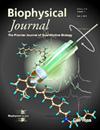Comparative Study on Efficacy of Thrombolytic Protocols: Dual Therapy against Standard tPA Regimen.
IF 3.2
3区 生物学
Q2 BIOPHYSICS
引用次数: 0
Abstract
When a blood clot occludes cerebral arteries, causing a stroke, a common cause of global death, thrombolytic therapy steps in as a highly effective treatment to restore the blood flow by dissolving the clot. Thrombolytic therapy is the use of plasminogen activators, including tissue plasminogen activator (tPA) and urokinase plasminogen activator (uPA), either separately or in combination. In this study, a mathematical model of thrombolysis has been developed for non-uniform fibrin clots, which have varying density levels nearer and farther from the cell surface. The non-Newtonian nature of blood flow and the viscoelasticity of vessel walls are considered. The dynamic of the pulsatile flow is described using the mass and momentum conservation laws with the Carreau viscosity model, and the generalized Maxwell model is used for the vessel wall. The transport of drugs and fibrinolytic factors involved in the dissolution process induced by convection and diffusion is considered. The developed model can predict the clot lysis pattern in combined drug therapies and can be used to optimize the drug dosage required for treatment. The model is used to evaluate the safety of dual thrombolytic therapy with tPA bolus and uPA continuous infusion in three different doses and then compared with the FDA-approved regimen and experimental studies. Results show that although dual thrombolytic therapy is safe and does not increase the risk of bleeding, it is not more effective than the FDA-approved regimen in faster clot dissolution and restoration of blood flow.溶栓方案:双重治疗与标准tPA方案的疗效比较研究。
当血凝块阻塞大脑动脉,导致中风,这是全球死亡的常见原因时,溶栓疗法作为一种非常有效的治疗方法,通过溶解血凝块来恢复血液流动。溶栓治疗是使用纤溶酶原激活剂,包括组织纤溶酶原激活剂(tPA)和尿激酶纤溶酶原激活剂(uPA),单独或联合使用。在这项研究中,已经建立了一个非均匀纤维蛋白凝块的溶栓数学模型,这些凝块在离细胞表面更近和更远的地方具有不同的密度水平。血流的非牛顿性质和血管壁的粘弹性被考虑在内。用质量守恒定律和动量守恒定律和careau黏度模型来描述脉动流的动力学,用广义Maxwell模型来描述血管壁。考虑了药物的转运和纤维蛋白溶解因子在对流和扩散诱导下的溶解过程。所建立的模型可以预测联合药物治疗中的凝块溶解模式,并可用于优化治疗所需的药物剂量。该模型用于评估三种不同剂量tPA单丸和uPA连续输注双溶栓治疗的安全性,并与fda批准的方案和实验研究进行比较。结果表明,虽然双重溶栓治疗是安全的,不会增加出血的风险,但在更快的凝块溶解和血流恢复方面,它并不比fda批准的方案更有效。
本文章由计算机程序翻译,如有差异,请以英文原文为准。
求助全文
约1分钟内获得全文
求助全文
来源期刊

Biophysical journal
生物-生物物理
CiteScore
6.10
自引率
5.90%
发文量
3090
审稿时长
2 months
期刊介绍:
BJ publishes original articles, letters, and perspectives on important problems in modern biophysics. The papers should be written so as to be of interest to a broad community of biophysicists. BJ welcomes experimental studies that employ quantitative physical approaches for the study of biological systems, including or spanning scales from molecule to whole organism. Experimental studies of a purely descriptive or phenomenological nature, with no theoretical or mechanistic underpinning, are not appropriate for publication in BJ. Theoretical studies should offer new insights into the understanding ofexperimental results or suggest new experimentally testable hypotheses. Articles reporting significant methodological or technological advances, which have potential to open new areas of biophysical investigation, are also suitable for publication in BJ. Papers describing improvements in accuracy or speed of existing methods or extra detail within methods described previously are not suitable for BJ.
 求助内容:
求助内容: 应助结果提醒方式:
应助结果提醒方式:


